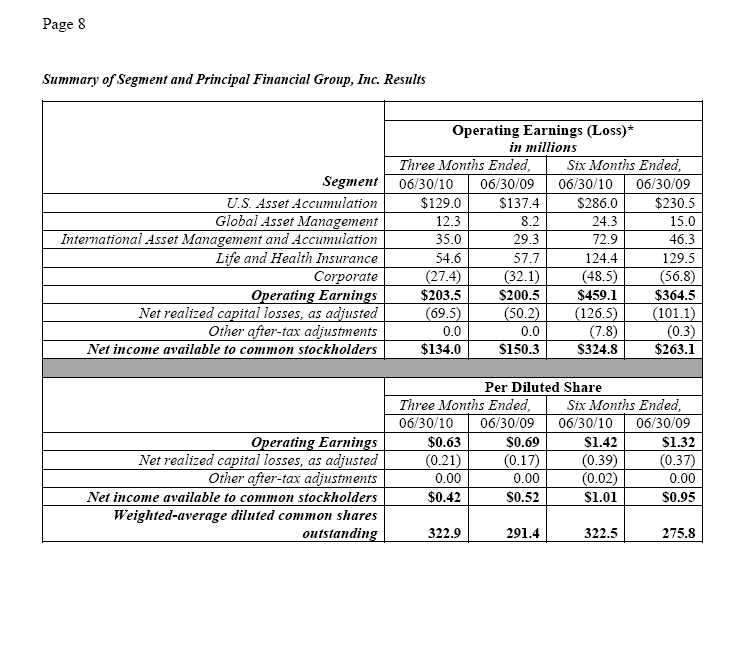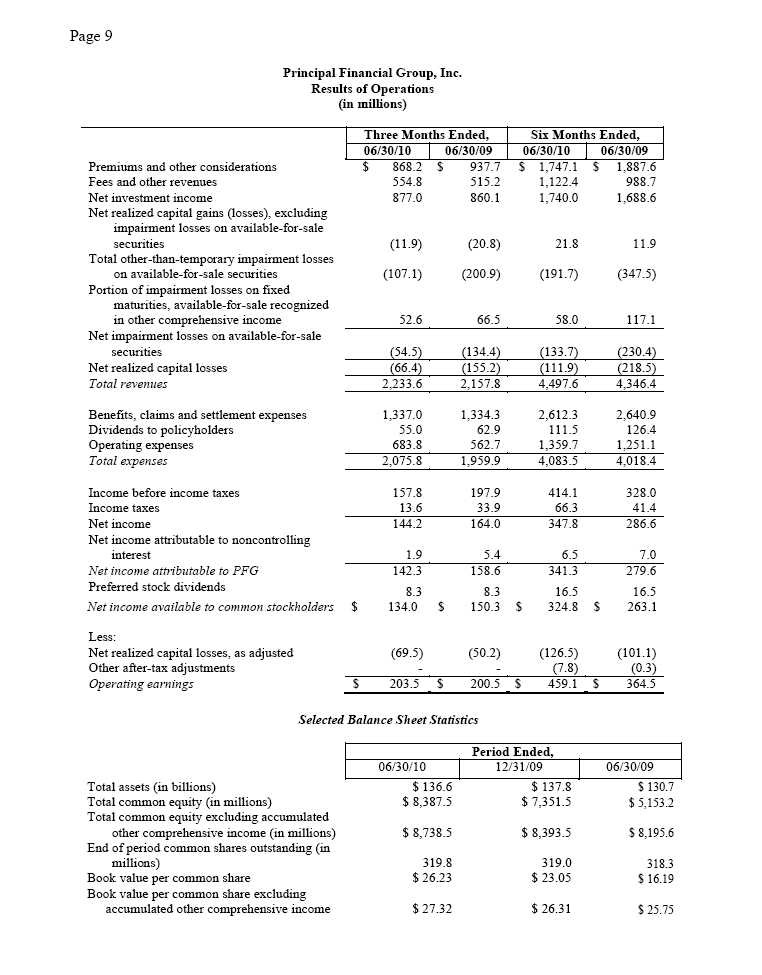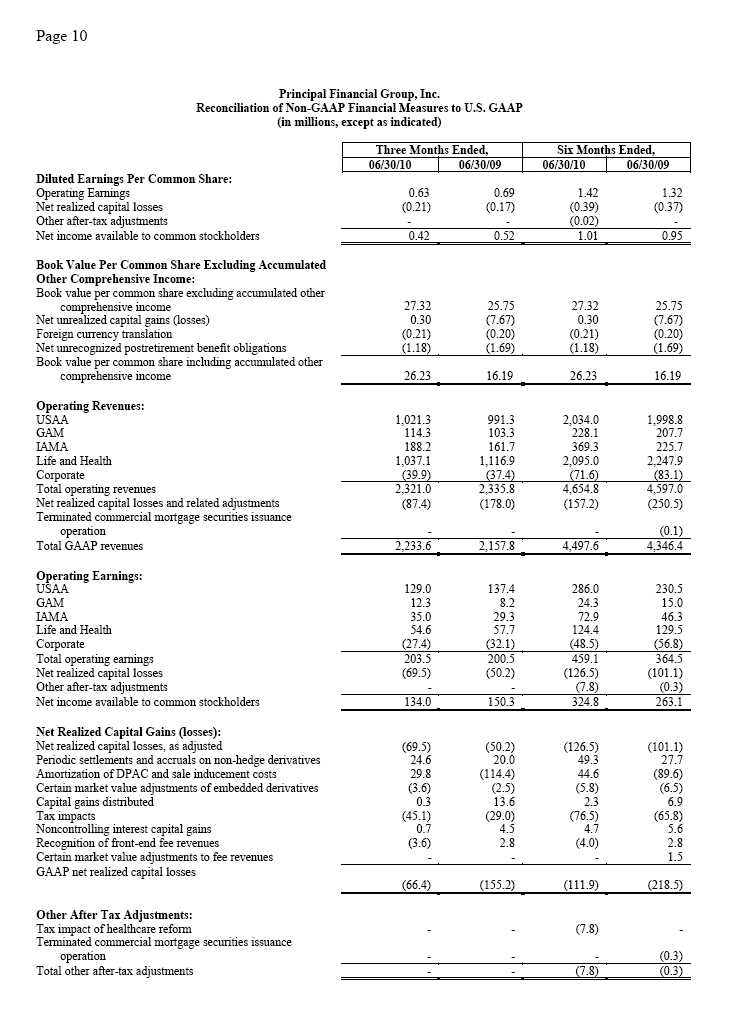|
| Page 6 |
| |
| quarter 2010, compared to $23.7 million in the same period a year ago. Individual Life earnings were $26.0 |
| million compared to $28.3 million in second quarter 2009, as growth in the block of business was offset by the |
| impact of equity market performance true-ups on DPAC amortization expense. The Health division had |
| operating earnings of $4.6 million in second quarter 2010 compared to earnings of $5.7 million for second |
| quarter 2009, reflecting the decline from a year ago in group medical covered members. |
| Operating revenues for second quarter were $1,037.1 million, compared to $1,116.9 million for the |
| same period a year ago. The decline was primarily due to a 16 percent decline in Health division premiums, |
| which primarily reflects a decline in group medical covered members. |
| |
| Corporate |
| Operating losses for second quarter 2010 were $27.4 million. This compares to operating losses of |
| $32.1 million in second quarter 2009, reflecting higher debt outstanding. |
| |
| |
| Forward looking and cautionary statements |
| This press release contains forward-looking statements, including, without limitation, statements as to |
| operating earnings, net income available to common stockholders, net cash flows, realized and unrealized |
| losses, capital and liquidity positions, sales and earnings trends, and management's beliefs, expectations, |
| goals and opinions. The company does not undertake to update or revise these statements, which are based |
| on a number of assumptions concerning future conditions that may ultimately prove to be inaccurate. Future |
| events and their effects on the company may not be those anticipated, and actual results may differ materially |
| from the results anticipated in these forward-looking statements. The risks, uncertainties and factors that |
| could cause or contribute to such material differences are discussed in the company's annual report on Form |
| 10-K for the year ended December 31, 2009, and in the company’s quarterly report on Form 10-Q for the |
| quarter ended March 31, 2010, filed by the company with the Securities and Exchange Commission, as |
| updated or supplemented from time to time in subsequent filings. These risks and uncertainties include, |
| without limitation: adverse capital and credit market conditions that may significantly affect the company’s |
| ability to meet liquidity needs, access to capital and cost of capital; a continuation of difficult conditions in |
| the global capital markets and the general economy that may materially adversely affect the company’s |
| business and results of operations; the actions of the U.S. government, Federal Reserve and other |
| governmental and regulatory bodies for purposes of stabilizing the financial markets might not achieve the |
| intended effect; the risk from acquiring new businesses, which could result in the impairment of goodwill |
| and/or intangible assets recognized at the time of acquisition; impairment of other financial institutions that |
| could adversely affect the company; investment risks which may diminish the value of the company’s |
| invested assets and the investment returns credited to customers, which could reduce sales, revenues, assets |
| under management and net income; requirements to post collateral or make payments related to declines in |
| market value of specified assets may adversely affect company liquidity and expose the company to |
| counterparty credit risk; changes in laws, regulations or accounting standards that may reduce |
| company profitability; fluctuations in foreign currency exchange rates that could reduce company |
| profitability; Principal Financial Group, Inc.’s primary reliance, as a holding company, on dividends from its |
| subsidiaries to meet debt payment obligations and regulatory restrictions on the ability of subsidiaries to pay |
| such dividends; competitive factors; volatility of financial markets; decrease in ratings; interest rate changes; |
| inability to attract and retain sales representatives; international business risks; a pandemic, terrorist attack or |
| other catastrophic event; and default of the company’s re-insurers. |
| |
| Use of Non-GAAP Financial Measures |
| The company uses a number of non-GAAP financial measures that management believes are useful to investors |
| because they illustrate the performance of normal, ongoing operations, which is important in understanding and |
| evaluating the company’s financial condition and results of operations. They are not, however, a substitute for |
| U.S. GAAP financial measures. Therefore, the company has provided reconciliations of the non-GAAP |
| measures to the most directly comparable U.S. GAAP measure at the end of the release. The company adjusts |


